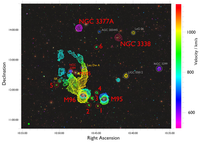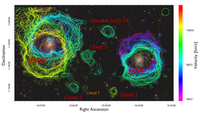The Leo Ring And Its Little Clouds
The Leo Group is famous for its giant Ring of HI, about 200 kpc in diameter. This was a natural target region for AGES, especially as with M33 we found such a larger gas disc than the previous observations. But this time, our sensitivity didn't turn up much extra gas in the Ring itself – not nothing at all, but nothing very dramatic, nothing to point at and say, "hah, the Ring isn't doing what we thought it was !". What we did find were six(ish) discrete little dark clouds, at least one of which has dark galaxy potential.
A much more fun interactive version of this figure is available here (you might need to download the file, just open it in any browser and it should work).
Exactly how many clouds we've found is a little bit hard to say. Cloud 5 is so close to the Ring it might just be an extended part of the structure, though I think it's probably a bit too separated for that. Cloud 4 does actually have an optical counterpart, so it's arguable whether we should include it here. That's a reasonable complaint, but it's very close to the others and has a similar size, HI mass and line width. In every respect it resembles the optically dark clouds – so is it a cloud that's "lit up", or just a normal galaxy that's in the wrong place at the wrong time ? We don't know. But it's a legitimate question, so it seems reasonable to include it in the analysis.
Another complication in quantifying the number of clouds comes if we smooth our data a little. This improves our sensitivity and reveals more cloud candidates, but it's hard to be certain if those really exist or are artifacts in the noise. We can't know for sure without more sensitive observations.
The smoothing shows that cloud 2 is connected to M96 by a narrow bridge of gas, while cloud 3 is significantly more extended than without smoothing. Cloud 1's appearance is not much changed, while cloud 4 is marginally more resolved. Assuming that the clouds are basically similar, this likely means the sizes of all the clouds are pretty close to the Arecibo beam size, and not likely to be very much smaller than they appear.
By far the most likely explanation is that clouds 1-3 are some form of tidal debris, produced by the interactions of the two massive spiral galaxies. But it's interesting that we don't see any sort of large-scale bridge of HI : with smoothing, we see the clouds are a bit larger than without, but we don't see any clear connection between the two spirals. We certainly don't see anything that resembles the classic tail-and-counter-tail structure that usually characterises tidal debris, which should be much larger than anything here except the Ring. And that cloud 4 is marginally resolved is quite interesting. Star formation requires denser gas, so we might have expected this one to be unusually compact in order to explain its star formation, but this is not the case. What's keeping the other clouds from forming stars, we don't know – equally, we can't say for sure if this cloud 4 is really just a normal galaxy or not.
In terms of dark galaxy potential cloud 6, much further north, is by far the best candidate in this region. Of course that whacking great Ring tends to overshadow everything else, but it's hard to imagine how the formation process could relate these two structures. The cloud is at about the same systemic redshift as the Ring, but it's twice as far from the centre as the Ring material and unresolved to our observations. What sort of process could produce this giant, coherent arc of material, and simultaneously this one, single compact little cloud with no signs of any extensions, is not at all obvious. And the galaxies nearest to cloud 6 are at quite different redshifts and likely to be in other groups entirely, so aren't likely candidate parents (they have no signs of extended emission anyway).
You're probably wondering : what about the damn Ring ? Well, me too ! But analysing that turns out to be a really fiendish beast of a problem. True, it almost certainly indicates that some horribly complicated interaction is happening here, and we're working on numerical simulations to come up with some possible scenarios. But we're a while off producing any publishable results on that front.
You can read a more detailed blog post about these clouds here.

